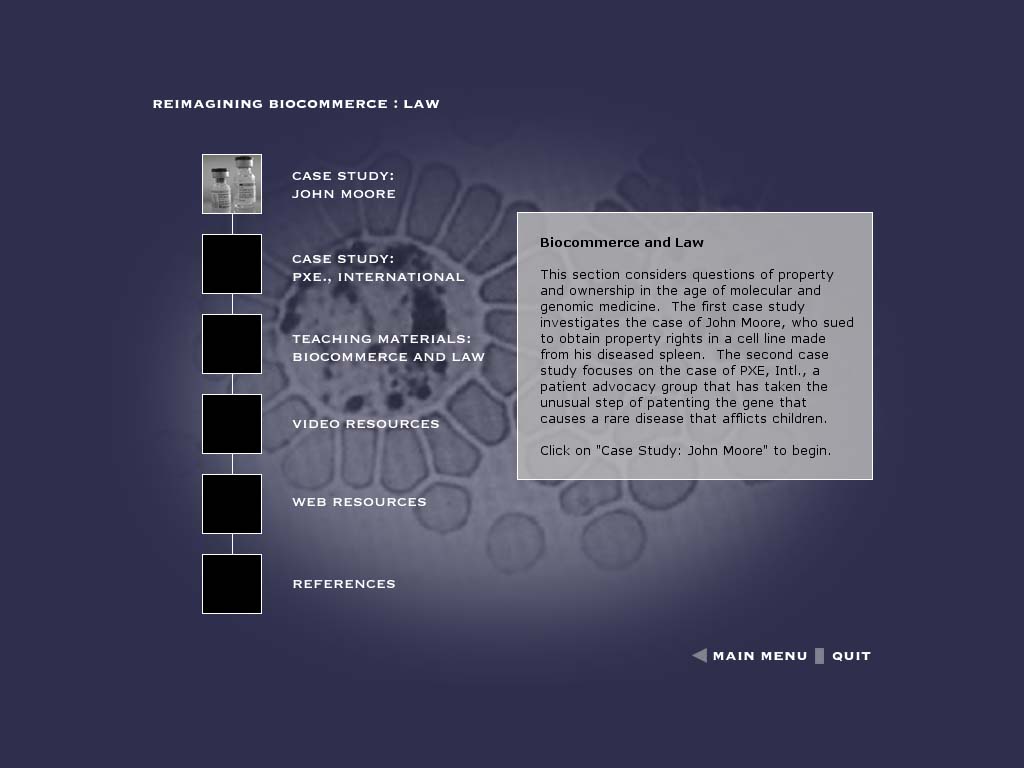« MIT Open Courseware: Introduction To Biology | Main | The Book as Landscape: Hypermedia Berlin »
November 17, 2005
Biofutures: Owning Body Parts and Information

Biofutures, a DVD-ROM about biotechnology and culture currently under development, grew out of conversations between three humanities scholars who shared a common interest in emerging forms of biotechnology. Rob Mitchell, an English Professor at Duke University affiliated with the Duke Institute for Genome Science and Policy and Phillip Thurtle, a molecular biologist turned anthropologist who now teaches at the University of Washington, had both encountered - translation problems - when trying to teach humanities students about biotechnology.
The two professors realized that if they were going to clearly communicate the social, cultural and legal issues that lay behind the case studies they tried to present, they had to find a simple way to get the science across. Aware that a conventional textbook or course pack would only bury their students in a tangle of sometimes overwhelmingly technical information, they decided to create a digital text of their own that could both sift through out the different types of issues connected with biotech research while providing accessible - and lively - explanations of the science involved.
In order to come up with a design for their project, Mitchell and Thurtle teamed up with Helen Burgess, a new media scholar teaching at the Program in Digital Technology and Culture at Washington State. Burgess had recently worked on DVD project that had similar goals of setting up a dialogue between science and society: The Red Planet: Scientific and Cultural Encounters with Mars (University of Pennsylvania Press, 2001). The team chose to divide the text into three primary chapters: Biology, which focuses primarily on the physiological, chemical, and technological processes that make biocommerce possible; Law, which discusses continuities and changes in intellectual property law that have determined the shape of contemporary biocommerce; and Culture, which examines the ways in which biocommerce has been represented in film, novels, and recent art projects.

Each chapter in turn features two 'case studies,' which provide a strong underlying narrative. Moving from page to page in the case study narratives, the user encounters clickable items that provide different kinds (and levels) of explanatory item, including video interviews with experts from the fields of genetics, history, and law; video footage and computer animations of basic lab genetic procedures essential to biocommerce; and clips from popular films that have helped establish public perceptions of the possibilities and dangers of biocommerce. Beyond these "case studies," chapters also provides teaching resources and external links.
In developing these items, Burgess has managed to achieve a delicate balance between depth of contextual content and the forward motion of narrative. Since the clickable items are a reasonable length - and the case study are sufficiently compelling - the user never feels sidetracked or distracted by the information presented; the narrative spell is not broken.
One of the most appealing features of Biofutures is that the demonstrations and expert interviews provide a sense of getting first-hand information from many different disciplinary perspectives at once: while many attempts at the cultural studies of science are grounded in a specific discipline (anthropology, sociology, literary study), the truly interdisciplinary nature of this project makes it teachable in a wide variety of classrooms. According to Burgess and Mitchell, the scientists involved in the expert interviews have gotten more interested in the idea of teaching cultural and social perspectives through their participation in the project, and are looking forward to the release of the DVD.
A detailed description of the project is available here
Posted by lisa lynch at November 17, 2005 11:32 AM
